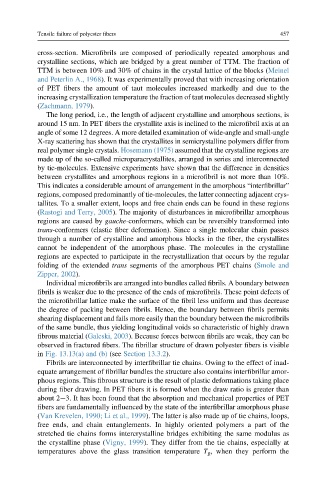Page 484 - Handbook of Properties of Textile and Technical Fibres
P. 484
Tensile failure of polyester fibers 457
cross-section. Microfibrils are composed of periodically repeated amorphous and
crystalline sections, which are bridged by a great number of TTM. The fraction of
TTM is between 10% and 30% of chains in the crystal lattice of the blocks (Meinel
and Peterlin A., 1968). It was experimentally proved that with increasing orientation
of PET fibers the amount of taut molecules increased markedly and due to the
increasing crystallization temperature the fraction of taut molecules decreased slightly
(Zachmann, 1979).
The long period, i.e., the length of adjacent crystalline and amorphous sections, is
around 15 nm. In PET fibers the crystallite axis is inclined to the microfibril axis at an
angle of some 12 degrees. A more detailed examination of wide-angle and small-angle
X-ray scattering has shown that the crystallites in semicrystalline polymers differ from
real polymer single crystals. Hosemann (1975) assumed that the crystalline regions are
made up of the so-called microparacrystallites, arranged in series and interconnected
by tie-molecules. Extensive experiments have shown that the difference in densities
between crystallites and amorphous regions in a microfibril is not more than 10%.
This indicates a considerable amount of arrangement in the amorphous “interfibrillar”
regions, composed predominantly of tie-molecules, the latter connecting adjacent crys-
tallites. To a smaller extent, loops and free chain ends can be found in these regions
(Rastogi and Terry, 2005). The majority of disturbances in microfibrillar amorphous
regions are caused by gauche-conformers, which can be reversibly transformed into
trans-conformers (elastic fiber deformation). Since a single molecular chain passes
through a number of crystalline and amorphous blocks in the fiber, the crystallites
cannot be independent of the amorphous phase. The molecules in the crystalline
regions are expected to participate in the recrystallization that occurs by the regular
folding of the extended trans segments of the amorphous PET chains (Smole and
Zipper, 2002).
Individual microfibrils are arranged into bundles called fibrils. A boundary between
fibrils is weaker due to the presence of the ends of microfibrils. These point defects of
the microfibrillar lattice make the surface of the fibril less uniform and thus decrease
the degree of packing between fibrils. Hence, the boundary between fibrils permits
shearing displacement and fails more easily than the boundary between the microfibrils
of the same bundle, thus yielding longitudinal voids so characteristic of highly drawn
fibrous material (Galeski, 2003). Because forces between fibrils are weak, they can be
observed in fractured fibers. The fibrillar structure of drawn polyester fibers is visible
in Fig. 13.13(a) and (b) (see Section 13.3.2).
Fibrils are interconnected by interfibrillar tie chains. Owing to the effect of inad-
equate arrangement of fibrillar bundles the structure also contains interfibrillar amor-
phous regions. This fibrous structure is the result of plastic deformations taking place
during fiber drawing. In PET fibers it is formed when the draw ratio is greater than
about 2e3. It has been found that the absorption and mechanical properties of PET
fibers are fundamentally influenced by the state of the interfibrillar amorphous phase
(Van Krevelen, 1990; Li et al., 1999). The latter is also made up of tie chains, loops,
free ends, and chain entanglements. In highly oriented polymers a part of the
stretched tie chains forms intercrystalline bridges exhibiting the same modulus as
the crystalline phase (Vigny, 1999). They differ from the tie chains, especially at
temperatures above the glass transition temperature T g , when they perform the

